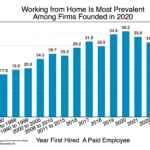Generating Content; Marketing Campaigns; Drug Discovery – It’s A Whole New World
Since ChatGPT launched 14 months ago, the media has been filled with tales of artificial intelligence and generative AI.
But all the talk of revolutionary success has been peppered with news reports about business disasters. So, what’s real and what’s hype? What has worked and what has failed?
Over the next few weeks, I’ll examine how AI and generative AI can work well in various supply chain functions. But today I’ll focus on general business applications where generative artificial intelligence can provide true benefits.
Generative AI is a quantum leap from “plain” AI (machine learning). Generative AI can reduce development time and costs, improve customer experience and satisfaction, boost innovation and creativity. All that points the way toward reduced costs, improved profitability and increased productivity.
Sounds like a path to competitive advantage to me.
What is Generative Artificial Intelligence?
Generative AI focuses on creating models and algorithms that can generate new, original content.
Traditional AI systems mainly analyze and make predictions from existing data. Essentially, they are large language models. Generative AI generates entirely new data that resembles patterns and characteristics from its training data. Images, video, music, speech, text, software code – generative AI tools can create them all.
To accomplish its tasks, generative AI uses deep learning and natural language processing. A generative AI tool can create an image of wild animals in a forest. But depending upon the prompt, the deer could be perched on a tree branch instead of pawing the ground to clear vegetation.
Generative AI Can Reduce Development Time and Costs
One main advantage? Generative artificial intelligence can speed up the development process, reducing the costs of creating new products, services or content. For instance, generative AI can help you:
- Generate rapid, unconventional ideas to expand creative possibilities for new product development, along with rapidly evaluating new designs.
- Generate new and original content in art, music and writing. This includes images and videos for use in gaming, virtual reality and product design. Think of developing an automated marketing video to showcase a new product.
- Simulate gaming environments to generate characters, natural landscapes and complex behaviors and interactions.
- Help fashion designers generate new patterns and styles by generating a vast range of options, streamlining the process.
- Software engineers can use generative AI to automate test writing for code. Forbes reports that speedier results are like adding 10%-15% more people to engineering teams.
Generative AI Can Improve Customer Experience and Satisfaction
Generative AI can improve customer experience and satisfaction by providing more engaging, relevant and customized content or services. A few examples:
- Chatbots and virtual assistants can generate human-like responses in natural language conversations. Chatbots can take care of many questions and scale difficult problems to the next level for human intervention.
- Generative AI can detect anomalies by learning the patterns of normal data. Exceptions can indicate potential fraud, cybersecurity threats or system failures.
- Generative AI can personalize recommendations with content tailored to user preferences. For example, in eCommerce, generative AI recommends products based on a user’s browsing and purchase history. Generative AI also can create personalized offers, discounts or coupons based on customer preference, behavior or location.
- Some companies are creating customized music, sound effects and voiceovers for products, services and content.
Generative AI: Profits, Costs and Productivity
Generative Artificial intelligence can create valuable IP assets like images, videos and music. Businesses can commercialize that IP.
Repetitive content creation with generative models can slash associated labor costs by 80% or more. By prompting generative AI for ideas, top creators can become even more creative. They can focus on strategy and judgment. They can pick the right content, the right headline, the right product or marketing slogan from rapidly generated ideas.
Publishers and social platforms can use it to grow engagement and ad revenue. And domain experts can have a wider impact.
In fact, researchers at MIT, Harvard, The Wharton School and Warwick Business School discovered that generative AI can improve worker performance by as much as 40%. But that’s only if highly skilled workers use AI within “the boundary of its capabilities.” Go outside that boundary and performance drops by 19%.
The researchers wrote that highly skilled workers should not blindly adopt AI outputs. Instead, they should validate AI and use their judgement.
So, Where Can I Use This Generative AI in Business?
Companies are successfully using generative AI in a number of functions:
- Marketing and sales: Lead scoring AI improved sales conversion rates by 30%, according to a McKinsey report. BCG detailed how personalized promotions increased average order value by 15%.
- Customer service: Chatbots can automate a number of inquiries, drastically improving response times.
- Finance: Automated audits can save thousands of staff hours. Predictive models can improve demand forecasting by 30%, according to a Bain report.
- Manufacturing: A BCG report detailed how computer vision inspection reduced defects by 35%, enabling a 5% increase in throughput.
- Logistics: Demand prediction AIs increase supply/demand matches by 20% or more, optimizing routes. Automated routing can help you use assets more efficiently, saving on fleet costs.
- Cybersecurity: Malware pattern recognition has reduced breach detection times. And security analytics AIs can help ID vulnerabilities.
- Healthcare: Pharmaceutical companies have used generative AI to create new drug molecules, accelerating research. Generative AI also could help with target identification and repurposing current drugs for other uses. (Target identification refers to choosing a disease with an unmet need or improving a current therapeutic.)
AI Technologies Can Trigger a Bright Future
AI, either generative or the “plain old kind,” does hold a number of pitfalls.
After all, you don’t want your use of AI to make the news like Gannett newspapers and iTutorGroup.
Gannett paused its use of AI after the service botched high school sports reports. Readers woke up to the following prose:
“The Worthington Christian [[WINNING_TEAM_MASCOT]] defeated the Westerville North [[LOSING_TEAM_MASCOT]] 2-1 in an Ohio boys soccer game on Saturday.”
And iTutorGroup had to pay the Equal Employment Opportunity Commission $365,000. The EEOC found that the business’ AI application review automatically rejected older men and women. This points to the critical need to train generative AI systems to avoid bias.
Despite those cases, generative artificial intelligence opens entirely new worlds in virtually every business sector. I’m excited to see the future of AI business applications. How about you?
Related Reading
AI for Warehousing – not Just for ChatGPT Anymore!
ChatGPT and AI – A Creator of Value AND Jobs?
ChatGPT is a Wave You Need to Ride, Not Deride
Jim Tompkins, Chairman of Tompkins Ventures, is an international authority on designing and implementing end-to-end supply chains. Over five decades, he has designed countless industrial facilities and supply chain solutions, enhancing the growth of numerous companies. He previously built Tompkins International from a backyard startup into an international consulting and implementation firm. Jim earned his B.S., M.S. and Ph.D. in Industrial Engineering from Purdue University.






